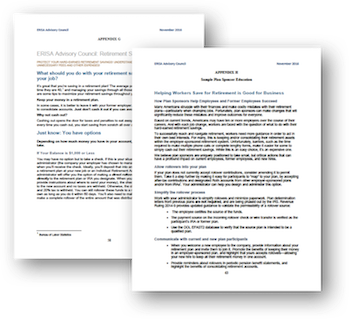
Why employers—old and new—should help employees with 401(k) transitions
You just landed your dream job. You give your notice, pack your belongings, say goodbye to your coworkers, but you have that nagging feeling you’ve forgotten something.
As you become immersed in your new job, that nagging feeling fades. Until you get a letter from your former employer’s retirement plan administrator. Seems you left a chunk of money behind in your 401(k), and they’d like to know what you want to do with it. Or at least you think that’s what they’re asking. The letter is written in almost indecipherable legalese, with choices that seem complicated—except for one: Take your account balance in cash. For many, this easy money is too hard to resist.
This is a situation your employees could face a dozen or more times during their careers. According to the Bureau of Labor Statistics, most Americans will have 10 different jobs by the time they hit 40. And with each job change, they’ll face complex questions about what to do with their hard-earned retirement savings from their previous employer(s).
While some people are contemplating this decision because they’re switching employers, others are wrestling with it (along with countless other emotions) after a layoff. Both scenarios come with tremendous stress and anxiety—terrible conditions for making rational decisions or thinking through long-term consequences. This toxic combination of complex choices and high emotions helps explain why almost half (45%) of all transitioning workers make decisions counter to their best interests, cashing out a staggering $1 trillion every year from defined contribution accounts. This decision costs people big time, and as employers, you’re positioned to make small, strategic moves to stem this tide.
Delivering a one-two punch to stop leakage from draining retirement dreams
The money trickling out of defined contribution (DC) plans through loans and pre-retirement withdrawals is known as leakage. And it’s draining many workers’ dreams of retirement. DC plan leakage—particularly the cash-outs that are allowed when job hopping—is jeopardizing the financial health of Americans, and it’s one of the issues the ERISA Advisory Council (EAC) recently asked for help from the Benz team to address.
Reporting to the Secretary of Labor, the EAC is charged with finding creative solutions to help plan sponsors lead the way to successful retirement for their employees. Through research and testimony, the EAC identified several solutions to stem the tide of DC plan cash-outs, including improving plan sponsor and participant education and communication.
We were honored to testify twice before the DOL on how critical retirement education and communication is to improving employees’ financial success, and thrilled when the EAC tapped us to partner with them to help bring to life their recommendations for improvements to DC plan sponsor and participant education.
Improving employer education
We get it. Retirement rules are c-o-m-p-l-e-x. One false move could expose employers to an avalanche of legal troubles. It’s tempting to just let your lawyers run the show to keep you out of hot water when giving exiting employees options for treating DC balances in your retirement plan. And while this may be a good short-term decision for your business, it’s having a profoundly negative effect on the ability of current, former, and future employees to retire:
- More than half of Americans are living paycheck to paycheck.
- The average household owes almost $135,000 to creditors, with $16,000 in credit card balances alone.
- And only 4 in 10 have emergency savings.
The easy money accessible from a retirement account because of a job change compounds money troubles, shortchanges futures, and creates serious anxiety about meeting expenses today and after retirement. And all the stress walks into your workplace every day, affecting employees and your business. Almost 40% of employees say financial stress has caused their productivity to suffer, with 25% missing work due to financial stress.
The suffering doesn’t end there. Employee “presenteeism” can affect your company’s reputation, quality, products, customers, sales, earnings, culture—you name it. In other words, employees’ financial health has considerable influence on an organization’s health.
 Our work with the EAC included contributions to its 2016 report, Participant Plan Transfers and Account Consolidation for the Advancement of Lifetime Plan Participation. We packaged actionable employer tips that identify specific ways to help both employees and employers succeed financially (Appendix G). They include: allowing rollovers into DC plans, simplifying the rollover process, encouraging current and new plan participants to explore rollover options, and making the options crystal clear to former employees. A set of FAQs helps answer many of the complex questions employers have about implementing the recommendations (Appendix H).
Our work with the EAC included contributions to its 2016 report, Participant Plan Transfers and Account Consolidation for the Advancement of Lifetime Plan Participation. We packaged actionable employer tips that identify specific ways to help both employees and employers succeed financially (Appendix G). They include: allowing rollovers into DC plans, simplifying the rollover process, encouraging current and new plan participants to explore rollover options, and making the options crystal clear to former employees. A set of FAQs helps answer many of the complex questions employers have about implementing the recommendations (Appendix H).
Make job hopping an opportunity for all employees to succeed
For most people, keeping their retirement money in an employer-sponsored plan is the way to go. Fees are typically lower compared to retail IRAs, keeping balances from being whittled away. Employer plans also generally offer a variety of investment options to choose from, allowing the opportunity for reasonable investment returns. And maintaining retirement money in “the system” prevents long-term savings from being slashed by early withdrawal penalties and taxes.
Ideally, all DC accounts are consolidated into a current employer’s plan, making it easier to see the full retirement picture and keep track of all your savings—leading to greater retirement security. Unfortunately, this can be easier said than done. Consolidating money from prior employers’ DC plans into a current employer’s plan often requires multiple phone calls or completing lengthy forms. The path of least resistance can be simply cashing out the retirement savings. While this is an easy choice, it’s an expensive one.
We worked with the EAC to develop a model notice for departing employees that boils down complex choices and “if-then” scenarios. Titled, “What should you do with your retirement savings when you leave your job,” this roadmap spells out the options in laymen’s terms and offers rule-of-thumb recommendations to counter the allure of seemingly easy money—such as, don’t cash out your retirement savings—and highlighting the potential landmines of doing nothing, such as having low balances swept into an IRA, with limited growth and high fees that eat away at balances.
It takes a village to make retirement a reality
When it comes to helping workers save for retirement, we advocate thinking about the bigger picture. You could argue that the retirement decisions made by departing workers are no longer your concern, but consider this: Your new hires probably came from another company. You want them to be focused, present, and engaged from day one—not worrying about what to do with their retirement savings. Wouldn’t it be great if their former employers invested a modest amount of time and effort to clearly explain their DC options to set them up for success with you? And wouldn’t you want to pay it forward by supporting these efforts for your departing employees?
While the world of retirement savings continues to evolve and improve, there are still significant obstacles to helping people successfully get to retirement. We’re honored to be part of the conversation both with our employer clients and on a national level with the EAC.
Need help getting your employees financially prepared for their futures? Let us know. We’d be thrilled to help.
Work with Us
We partner with organizations that value their people first. Let’s talk.

Rita Harris, VP Senior Consultant, is known for her ability to break down complex benefits programs into their essential parts, so employees can quickly assess “what’s in it for me.”
